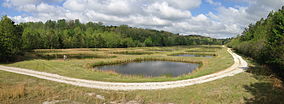University of Mississippi Field Station
| University of Mississippi Field Station | |
|---|---|
 |
|
| Location | Lafayette County, Mississippi, United States |
| Nearest city | Oxford, MS |
| Coordinates | 34°25′57″N 89°23′26″W / 34.4326°N 89.3905°WCoordinates: 34°25′57″N 89°23′26″W / 34.4326°N 89.3905°W |
| Area | 787 acres (318 ha) |
| Established | May 1986 |
| Governing body | University of Mississippi |
| http://fieldstation.olemiss.edu/ | |
The University of Mississippi Field Station (UMFS) is a 787-acre (318 ha) off-campus research and education complex located in Lafayette County, Mississippi about 8 miles (13 km) northeast of downtown Oxford and operated by the University of Mississippi.
In July 1947, the area that is now the UMFS opened as Ole Miss Fisheries, Inc., a fish farm that later became Minnows Incorporated and operated by the Herbert Kohn Corporation. The fish farm comprised 165 acres (67 ha) of bottomland along the Bay Springs Branch of Puskus Creek that was purchased from the Hickey family. The original ponds were irregularly arranged, filled from springs through pipes in the levees, and emptied via standpipes in the corner of each pond. After the original ponds, newer ponds had concrete outlet structures for drainage, and most current ponds have PVC standpipes. At its peak, the fish farm produced three million to four million fish per year. Eighty percent of these fish were golden shiners, and the rest were goldfish. After the construction of the first set of ponds, the area alongside an unnamed stream stretching about 1 mile (1.6 km) southwest of Bay Springs Branch was dynamited for drainage and cleared of timber. An additional 65 ponds were constructed here in a double row and the stream rerouted so that it flowed in two channels on the sides of the valley. Attempts were made to raise trout, but these were not successful due to their low temperature requirements and the low levels dissolved substances in the water at UMFS. Additional attempts to raise American bullfrogs were also not successful, possibly due to predation on the tadpoles or the spread of disease in confined spaces. Grazing cattle, along with the fish farm’s crew, maintained low levels of vegetation growth around the ponds.In the early 1980s, the farm ceased operations and was sold to Weyerhaeuser where it remained fallow for two to three years, during which time much of the area became overgrown with vegetation.
In 1985 the University of Mississippi acquired the property in a land trade with Weyerhaeuser and converted seven of the original ponds into 45 0.1 acres (0.040 ha) ponds with uniform surface areas and depths. On the southwestern side of the UMFS ten ponds were likewise converted to forty shallow, uniform ponds. The Natural Resources Conservation Service partially funded the construction of eight wetland cells at the western end of the field station. This construction resulted in 220 ponds covering with 90 acres (36 ha) of water at UMFS. However, today there are around 190 ponds, several of which are dry and some of which have been combined into a single pond due to beaver activity. The Mississippi National Guard Engineering Company C constructed the 45 0.1-acre (0.040 ha) ponds and a house for the field station’s manager during two summer camps in 1990 and 1991. The UMFS was dedicated in May 1986 as the University of Mississippi Biological Field Station (“biological” was later dropped from the name) and encompassed approximately 500 acres (200 ha). An additional 220 acres (89 ha) encompassing what was known as the old Bramlett farm were purchased, and in April 1996 15 acres (6.1 ha) were acquired to provide access to new laboratory, office, and maintenance buildings that were completed in 1998. In 2013 41.36 acres (16.74 ha) were added to the field station to protect against encroachment.
...
Wikipedia

